Flash In The Pan
Flash In The Pan
Flash In The Pan
 Cooked whole, fried radish leaves are melt-in-your-mouth crispy.
Ari LeVaux
Cooked whole, fried radish leaves are melt-in-your-mouth crispy.
Ari LeVaux
Latest Article|September 3, 2020|Free
::Making Grown Men Cry Since 1992

 Cooked whole, fried radish leaves are melt-in-your-mouth crispy.
Ari LeVaux
Cooked whole, fried radish leaves are melt-in-your-mouth crispy.
Ari LeVaux

“Plant offal” includes carrot tops and spinach bottoms.
Ari LeVaux

Cooked whole, fried radish leaves are melt-in-your-mouth crispy.
Ari LeVaux
